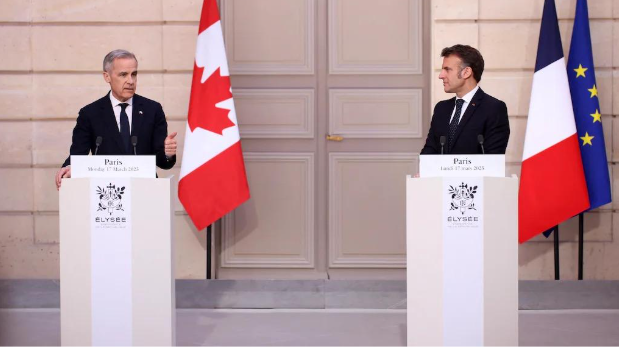After the Elections – Canada between the EU and the United States
By: Lavinia Tacke
Reading time: 6 minutes
On Monday, April 28, Canada elected a new Prime Minister after the former leader, Justin Trudeau, resigned as leader of the Liberal Party and as Prime Minister in January. The new Prime Minister is Mark Carney, who already took over after Trudeau’s early resignation. Carney’s main campaign promises were to cut taxes for the middle class and to remove trade barriers between the provinces.
Carney’s response to Trump
In his victory speech on the morning of Tuesday, April 29, Carney directly addressed US President Donald Trump, stating “President Trump is trying to break us so that America can own us,” but that this will “never ever happen.” Furthermore, he explains the world is experiencing a turning point that is “one of those hinge moments of history.” He describes the long stable relationship with the United States as “over”. Carney clarifies that he will discuss the US-Canadian “economic and security relationship,” but emphasizes that the US is not the only option for building Canadian prosperity.
On Tuesday, May 6, Carney visited the Oval Office to talk to Trump about several topics, one of which was the future relationship between Canada and the United States. The news organization CNN later characterized the meeting as “neither openly hostile nor outwardly chummy.” While Trump once again claimed that Canada becoming the 51st state of the United States would be beneficial to Canadians and would create a “beautiful formation” on the map, Carney continued to state that this will not happen.
Canada and the EU: A potentially deepening relationship
Furthermore, the newly elected Prime Minister states that Canada will strengthen its “relations with reliable partners in Europe, Asia and elsewhere”.Canada has historically maintained a close relationship with Europe.In 2016, the European Union and Canada signed a Strategic Partnership Agreement (SPA) that strengthened “political dialogue” in areas such as, international peace and security, justice, and sustainable development. Moreover, the Canada-European Union Comprehensive Economic and Trade Agreement (CETA), which entered into force in 2017, deepening their trade ties. According to the Canadian government, the EU is “Canada’s second-largest trading partner”.
After Donald Trump announced his plans to make Canada the 51st state of the United States, it became clear that many Canadians would instead be in favor of an accession to the European Union. A poll that was conducted in February 2025 – before the US imposed tariffs on many countries – shows that slightly less than half of the Canadian population would be in favor of Canada joining the EU. While the European Union has reacted “warmly to the results,” it has also referred to Article 49 of the Treaty on the European Union, which states “that only European states” can join the EU. Despite the unlikelihood of Canada joining the EU, it is not impossible, according to the American newspaper POLITICO. Giselle Bosse, a professor at Maastricht University, stated that “being European is more of a state of mind,” referring to the overseas territories of some member states. Bosse emphasized the belief in the welfare state that Canada and the EU share. While scholars argue that Canada’s accession to the EU is probably not “feasible in the short term, because of the procedures and the state of the union and enlargement,” they could deepen their economic ties to the European Union.
Meeting between Prime Minister Carney and President Macron on March 17, 2025
The Canadian Governmental System
Unlike most European countries, Canadian elections follow the “First Past the Post (FPTP)” system that was established in the United Kingdom and is still used by some Commonwealth countries, including Canada and India, as well as the United States. Similar to the British Parliament, the Canadian legislative branch consist of the Senate, also referred to as the upper house, and the House of Commons, also called the lower house. While the 105 senators are “appointed by the Governor General on the advice of the Prime Minister,” the House of Commons is directly elected by the citizens. Under the First Past the Post system, the number of the electoral districts won, called ridings in Canada, determines the number of seats each party gets in parliament and, consequently, who becomes prime minister. The Prime Minister is the head of the Canadian government, while the head of state is the British monarch, King Charles, represented by the Governor General.
What comes next?
As the Liberal Party failed to form a majority government, the opposition parties Bloc Québécois and the New Democratic Party may play an important role in passing legislation in the future. Although the Conservative Party received its highest number of votes in decades, its leader, Pierre Poilievre, lost his seat in the Canadian Parliament. Although Poilievre, often associated with ‘Trump-style’ policies, was considered a strong contender for Canada’s leadership by late 2024, both he and his party experienced a sharp decline in support following the implementation of Trump-era tariffs..
Conservative Party leader Pierre Poilievre lost his seat in the House of Commons
https://thelogic.co/news/election-pierre-poilievre-economic-braintrust/



